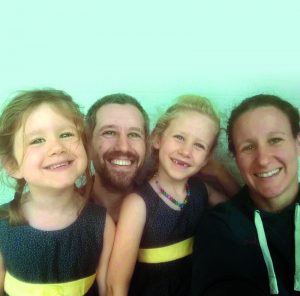Laura Ansbro meets up with two families to see how they deal with living gluten-free…
Going gluten-free can be daunting. It might even feel impossible when you first start out. Gluten is everywhere, almost unavoidable, seemingly irreplaceable, hiding in the most unlikely foods. This becomes even more challenging in a household where not everyone follows a gluten-free diet. How do you cope? In the first part of our Gluten Freedom Series, two families share the challenges and their top tips…
Claire & Jim
Jim and Claire have two children: Em, 4 and Jess, 6. Jess has been a suspected coeliac since infancy, following months of discomfort and sickness culminating in a hospital visit when a stomach bug affected Jess more severely than her peers. This was the first time that Claire and Jim found out about gluten and coeliac disease. Jess has not had a full diagnosis as her parents didn’t feel it was right for her to undergo a biopsy at such a young age.
What’s the biggest challenge?
Claire: We often make spontaneous decisions to turn a morning outing into a day trip or accept a friend’s invitation for lunch, so we need to make sure Jess is catered for. It’s getting easier to find cafés with gluten-free options, but combining a 6-year-old’s fussiness with an impromptu need for food isn’t always easy. Kids’ menus are often more gluten-heavy, so Jess can feel left out when her friends choose their own food but she is left with the emergency sandwiches we packed just in case.
How do you manage at home?
C: We have a 4-slice toaster so that half can be gluten-free. We use squeezy jam, mayonnaise and honey, refilling these from more cost-effective jars so that we all use the same condiments. When Jess was little, we had to be careful that she didn’t share a cup with her sister; it was the most frequent cross-contamination for a couple of years.
How do you manage when you’re out?
C: I always take an emergency packed lunch for Jess – gluten-free wraps and a jar of peanut butter have got us through many impromptu lunches. I keep a packet of gluten-free pasta and jar of sauce in the car, which is easy to add to a meal if we’re eating with friends. Birthday parties are hardest, but friends are happy to add gluten-free food to a buffet. We tend to ask what kind of birthday cake there will be, and make a gluten-free version so that Jess can take a slice.
What are your star recipes?
C: Jess can eat oats, so we make gluten-free flapjacks. We use cornflour to make Yorkshire puddings or rice flour for the best French crepes.
Have you found any advantages?
C: We’ve got into the habit of cooking from scratch so we’re probably eating more healthily, especially snacks. It’s cheaper and easier to have fruit and veg sticks when the kids have friends over than to provide gluten-free food for all or separate snacks. We take a picnic on family days out, so we can explore exciting destinations such as deserted forests and empty beaches that we might otherwise never have discovered!
Claire’s top tip
★ Our absolute favourite is to use rice crumbs to coat fish fingers or chicken nuggets. I wouldn’t use anything else, even if I wasn’t cooking gluten-free.
Rachel & Mark
Rachel and Mark have two children: Skye, 3, and Walter, 1. Mark has been following a gluten-free diet for three years, following several years of stomach problems and invasive testing. A private blood test identified a long list of intolerances, which Mark cut out of his diet for 6 months, before gradually reintroducing. Gluten, soya and barley are the only foods that Mark has been unable to reintroduce.
What’s the biggest challenge?
Rachel: Mark misses the texture of baked goods, especially cakes and biscuits. Sadly my gluten-free baking escapades have not been very successful. We end up buying ready-made gluten-free baked products, which are generally high in sugar and super expensive, so these are reserved solely for Mark.
How do you manage at home?
R: As Mark isn’t coeliac, we don’t have to be too careful about cross-contamination. When I’m making sandwiches, Mark’s are made first on a clean chopping board. If I’m baking, I often make two of everything, and I’ll make the gluten-free version first.
How do you manage when you’re out?
R: It has taken us a while to get this right! If we eat out, we check menus before we go so Mark knows whether there is anything suitable for him. If we’re invited to barbeques, we find that most things are okay for him to eat, but we take our own gluten-free rolls.
What are your star recipes?
R: I have a fail-safe pancake recipe! I substitute gluten-free flour, and use cottage cheese to make them light and fluffy. Otherwise, you’d be surprised about what you can eat that naturally doesn’t contain gluten. We cook food from scratch and use shop-bought gluten-free pasta if we are fed up with rice or noodles.
Have you found any advantages?
R: It forces us to buy fresh, unprocessed foods and cook from scratch, so a winner for all the family.
Rachel’s top tip
★ Learn how to read food labels, especially if you buy processed foods. Shop around; most supermarkets now offer a selection of gluten-free foods. Our favourite is Morrisons.
There’s plenty of support available online. Visit www.coeliac.org.uk or join online communities to share knowledge and experiences. Facebook groups for support: Coeliacs in the UK, Coeliacs Eat In Too!
Find more gluten-free articles here!


